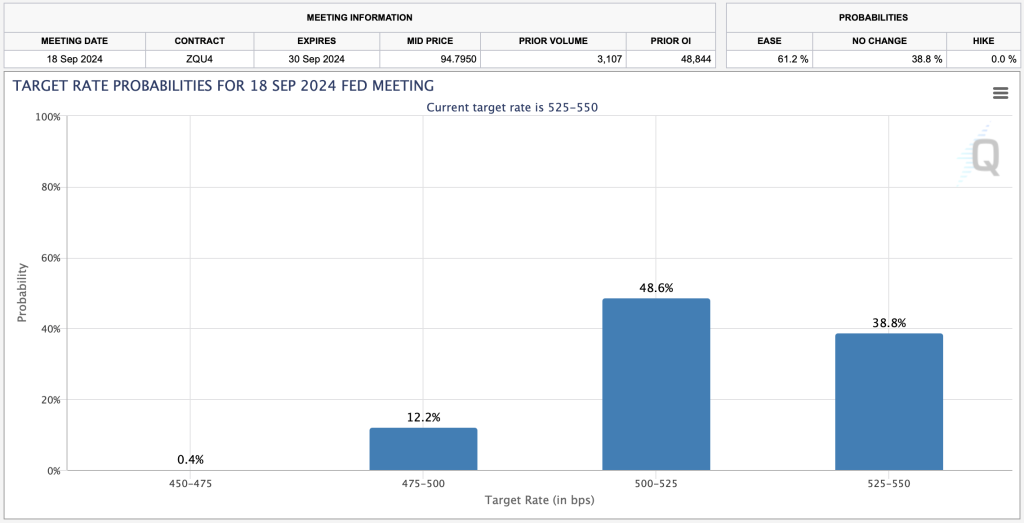Bitcoin could reach $100,000 before the end of 2024, causing a handful of altcoins to surge in value.
A bull-cycle is a period of time where assets raise in price because of a high demand from investors, relative to the available supply. This approach, despite being very simplistic, can guide us to a few valuable insights in preparation for the upcoming bull-cycle in crypto.
The recent Bitcoin halving on April 23, 2024, was a very important moment for our discussion. Not because it would magically increase Bitcoin’s price. But because it lowered the supply far below the demand we see right now. To put things in perspective, the inflow into the largest Bitcoin ETF funds is on average 3.500 BTC per day. After the halving, only 450 new BTC per day are being issued!
This brings me to my second point: Bitcoin ETFs and institutional investors. Despite the potential implications of Bitcoin being used as a store of value rather than a currency, as initially intended, the Bitcoin ETF were the second big thing in the supply & demand balance.
Why? They opened the doors to large institutional investors who, for the first time in Bitcoin history, have access to the market through their traditional channels. Obviously Grayscale Bitcoin Trust facilitated this already for a number of large investors. However, this is now available at a scale we have never seen before. At the current BTC/USD rate, a stunning $2,1 billion a day is flowing into Bitcoin through the ETF funds.
These two factors could already kick-start the upcoming bull-cycle. But I think there is one missing element to it: new retails investors. As long as crypto assets are not available for retail investors, we will not see the exponential growth we have seen in all the post-halving bull-cycles. And for retail investors to get in, we need to take a look at what is happening with interest rates and inflation. As long as the average Joe is worried about their mortgage or their groceries getting more and more expensive, not a single cent will go into crypto assets, stocks, or any other asset for that matter.
So, here’s what I see happening at macro level that could help understand what is next for interest rates and inflation: the last triggers for the upcoming bull-cycle.
Interest Rate Cut
For most of March and April, investors were exceptionally risk-conscious. Inflation consistently ran higher than expected, sparking fears that the Fed would not cut interest rates this year. Some investors even began to worry that the Fed might raise rates again. As a result, expected interest rate cuts for 2024 dropped from 100 basis points at the beginning of March to just 25 basis points by the end of April.
With this sentiment, cryptocurrencies faced challenges.
However, over the past week, several developments prompted the market to expect more interest rate cuts again.
Firstly, Fed Chairman J. Powell stated on Wednesday at the post-FOMC press conference that the central bank maintains its preference for interest rate cuts. He did not sound overly concerned about recent inflation trends. Moreover, Powell stated that the Fed is not considering rate hikes and that if things unfold as expected, the Fed would need to lower rates in the future.
These comments alleviated market concerns about a rate hike, increased the chances of interest rate cuts, and improved risk sentiment.
Furthermore, April’s job figures released on Friday showed weakening labor market conditions and decreasing wage inflation, giving the Fed even more reason to cut rates.
On the same day, the April ISM Services Report revealed that the US service sector entered contraction territory last month for the first time since December 2022, providing further support for the argument for interest rate cuts.
Overall, last week’s data impressively supports the idea that the Fed will cut rates multiple times this year. That is why expectations for interest rate cuts surged stronger in the last two days of the week with the first cuts expected as early as September 2024.

Consumer Inflation
After reviewing recent earnings reports from major consumer companies, it has become clear to me that consumers are fed up with ‘paying top dollar’ for goods and services.
Nearly every consumer company reporting earnings in the past two weeks mentioned something related to consumers becoming more price-sensitive or value-seeking and that they are sacrificing margins. Moreover, these companies have all expressed willingness to accommodate consumers and have broadly stated that they are done raising prices and will instead begin lowering them.
With that said, my expectation is high that inflation will decrease this summer.
If this happens, the market will increase expectations for interest rate cuts in 2024. This will lead to a significant drop in government bond yields. When government bond yields fall, Bitcoin usually performs very well.
Final Thoughts
I feel there might be a small window of opportunity with the Fed temporarily lowering interest rates in a market where we ‘got used’ to a relatively high level of inflation.
This means that the upcoming bull-cycle might be short-lived. It will all depend on how long we can sustain these levels of inflation in our daily lives and at what point central banks have to take stronger measures to set the foundation for recovery and ‘new growth’.
In the meantime, if you are positioned correctly in the market, investors can take advantage of the upcoming bull-cycle, however short it might end up being. A good indicator that times are changing is typically when you either start seeing ‘way too many’ commercials inviting the average Joe to invest in crypto or a taxi driver asks you about ‘yet another hot meme coin’ he might have missed. In both cases, it might be time to take profits. #notfinancialadvice
Newsletter
Stay up-to-date with the latest developments in the stock and crypto market., fund, and crypto market.
Disclosure
These are unqualified opinions, and this newsletter, is meant for informational purposes only. It is not meant to serve as investment advice. Please consult with your investment, tax, or legal advisor, and do your own research.




No comment yet, add your voice below!